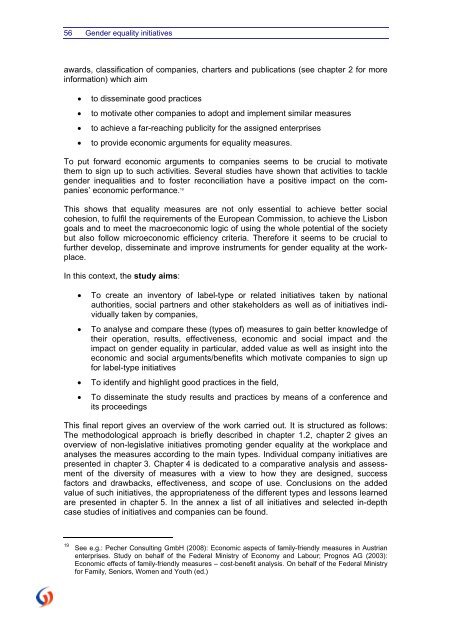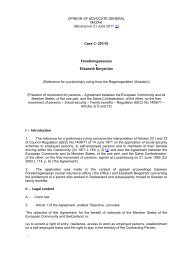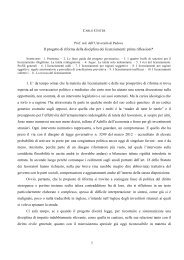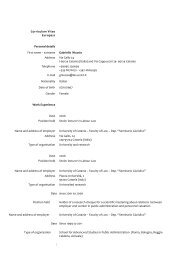Study on non-legislative initiatives for companies to promote gender ...
Study on non-legislative initiatives for companies to promote gender ...
Study on non-legislative initiatives for companies to promote gender ...
You also want an ePaper? Increase the reach of your titles
YUMPU automatically turns print PDFs into web optimized ePapers that Google loves.
56 Gender equality <strong>initiatives</strong><br />
awards, classificati<strong>on</strong> of <strong>companies</strong>, charters and publicati<strong>on</strong>s (see chapter 2 <strong>for</strong> more<br />
in<strong>for</strong>mati<strong>on</strong>) which aim<br />
• <strong>to</strong> disseminate good practices<br />
• <strong>to</strong> motivate other <strong>companies</strong> <strong>to</strong> adopt and implement similar measures<br />
• <strong>to</strong> achieve a far-reaching publicity <strong>for</strong> the assigned enterprises<br />
• <strong>to</strong> provide ec<strong>on</strong>omic arguments <strong>for</strong> equality measures.<br />
To put <strong>for</strong>ward ec<strong>on</strong>omic arguments <strong>to</strong> <strong>companies</strong> seems <strong>to</strong> be crucial <strong>to</strong> motivate<br />
them <strong>to</strong> sign up <strong>to</strong> such activities. Several studies have shown that activities <strong>to</strong> tackle<br />
<strong>gender</strong> inequalities and <strong>to</strong> foster rec<strong>on</strong>ciliati<strong>on</strong> have a positive impact <strong>on</strong> the <strong>companies</strong>’<br />
ec<strong>on</strong>omic per<strong>for</strong>mance. 19<br />
This shows that equality measures are not <strong>on</strong>ly essential <strong>to</strong> achieve better social<br />
cohesi<strong>on</strong>, <strong>to</strong> fulfil the requirements of the European Commissi<strong>on</strong>, <strong>to</strong> achieve the Lisb<strong>on</strong><br />
goals and <strong>to</strong> meet the macroec<strong>on</strong>omic logic of using the whole potential of the society<br />
but also follow microec<strong>on</strong>omic efficiency criteria. There<strong>for</strong>e it seems <strong>to</strong> be crucial <strong>to</strong><br />
further develop, disseminate and improve instruments <strong>for</strong> <strong>gender</strong> equality at the workplace.<br />
In this c<strong>on</strong>text, the study aims:<br />
• To create an inven<strong>to</strong>ry of label-type or related <strong>initiatives</strong> taken by nati<strong>on</strong>al<br />
authorities, social partners and other stakeholders as well as of <strong>initiatives</strong> individually<br />
taken by <strong>companies</strong>,<br />
• To analyse and compare these (types of) measures <strong>to</strong> gain better knowledge of<br />
their operati<strong>on</strong>, results, effectiveness, ec<strong>on</strong>omic and social impact and the<br />
impact <strong>on</strong> <strong>gender</strong> equality in particular, added value as well as insight in<strong>to</strong> the<br />
ec<strong>on</strong>omic and social arguments/benefits which motivate <strong>companies</strong> <strong>to</strong> sign up<br />
<strong>for</strong> label-type <strong>initiatives</strong><br />
• To identify and highlight good practices in the field,<br />
• To disseminate the study results and practices by means of a c<strong>on</strong>ference and<br />
its proceedings<br />
This final report gives an overview of the work carried out. It is structured as follows:<br />
The methodological approach is briefly described in chapter 1.2, chapter 2 gives an<br />
overview of n<strong>on</strong>-<strong>legislative</strong> <strong>initiatives</strong> promoting <strong>gender</strong> equality at the workplace and<br />
analyses the measures according <strong>to</strong> the main types. Individual company <strong>initiatives</strong> are<br />
presented in chapter 3. Chapter 4 is dedicated <strong>to</strong> a comparative analysis and assessment<br />
of the diversity of measures with a view <strong>to</strong> how they are designed, success<br />
fac<strong>to</strong>rs and drawbacks, effectiveness, and scope of use. C<strong>on</strong>clusi<strong>on</strong>s <strong>on</strong> the added<br />
value of such <strong>initiatives</strong>, the appropriateness of the different types and less<strong>on</strong>s learned<br />
are presented in chapter 5. In the annex a list of all <strong>initiatives</strong> and selected in-depth<br />
case studies of <strong>initiatives</strong> and <strong>companies</strong> can be found.<br />
19<br />
See e.g.: Pecher C<strong>on</strong>sulting GmbH (2008): Ec<strong>on</strong>omic aspects of family-friendly measures in Austrian<br />
enterprises. <str<strong>on</strong>g>Study</str<strong>on</strong>g> <strong>on</strong> behalf of the Federal Ministry of Ec<strong>on</strong>omy and Labour; Prognos AG (2003):<br />
Ec<strong>on</strong>omic effects of family-friendly measures – cost-benefit analysis. On behalf of the Federal Ministry<br />
<strong>for</strong> Family, Seniors, Women and Youth (ed.)
















